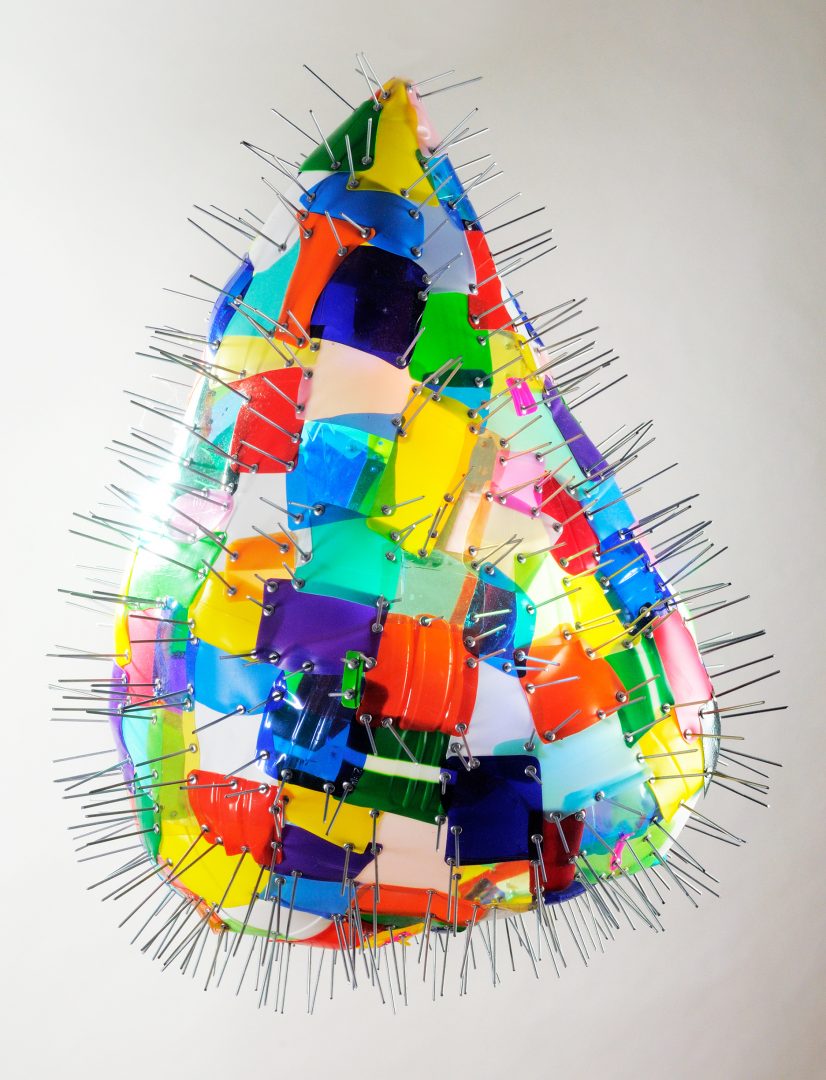The title of Marisa Merlin’s art installation “MERMAID’S TEARS” derives from the name given to small plastics beads you can find in every sea and ocean in the world.
“Mermaid’s tears”, also known as resin pellets or nurdles, are used in the manufacturing of plastic, while microbeads are used in many cosmetic products. But they also come from our discarded plastics objects too, accidentally and/or deliberately abandoned in the environment and then dumped into the oceans, broken down into ever smaller fragments via the process of water erosion and photodegradation, harming marine life and affecting human health.

Plastic is versatile, economical, colourful: attractive qualities that lead us to an excessive consumption of plastic goods, added to our propensity to consume more and more, discard, dirty and therefore pollute, they become a lethal combination for the environment.Every piece of plastic abandoned in the sea is eroded and photodegraded into smaller and smaller pieces for hundreds of years. The mermaid’s tears are similar to plankton and fish eggs and absorb other pollutants. They are mistaken for food from marine animals, entering in this way the human food chain. The artist’s installation “MERMAID’S TEARS” is composed of a variable number of elementary shapes, made with hundreds of pieces of daily plastic waste, joined by metal rivets. As real ones, at first sight, the “Mermaid’s Tears” are attractive and cheerful because of bright colours, but on closer look, the appearance is actually thorny, dangerous and unfriendly due to the rivets nails, deliberately in contrast with the vibrant colours.
The installation aims to draw attention to the individual responsibility and ask questions to move towards the awareness of the relevance of our daily choices, even small ones.
For its meaning, the “Mermaid’s Tears” were already exhibited in Venice, at the CNR-ISMAR headquarters (National Research Council, Marine Science Institute) within the European project ‘Life-Ghost’ on marine litter, ghost nets and microplastics (HERE)
3 Actions
The installation “Mermaid’s tears” can easily have developments to involve locals and visitors through actions and artistic workshops for people of all ages, to reflect on everyday individual acts and choices, sometimes apparently insignificant:
1 – ask questions: Collective actions, even through games, to identify our gestures and daily choices regarding the destination of plastic waste. Is it really necessary all the plastic I buy? where it goes? how do I dispose of it?
2 – to see practically (the hands think): Workshops of the community production of parts of the installation “Mermaid’sTears” with material coming from own daily plastic waste, highlighting how much plastic exactly each of us discards in a day, and how we dispose of it.
3 – be part of the solution: collective actions of shared identification of positive actions to reduce personal plastic waste. Changing habits cause a change in the production of common use goods. Through dynamic working groups identify actions for a life plastic-free, as much as possible, and become part of the solution…
About the artist:
Marisa Merlin was born in 1953 in Costa di Rovigo, a small town in Italy.
Her training background is quite varied, rich and not formal. Every day, she keeps on studying and experimenting art themes and techniques, following a personal path of interests and comparisons.
Her artistic research has always been focused on the reinterpretation of social and environmental issues, with the aim to stop the attention on them with my works, for an idea of the future and an awareness of personal responsibility. This gives the meaning of all my actions, both as artist and citizen, believing everyone is an agent of change.
For several years Merlin was oriented towards large site-specific installations, often ephemeral Land Artworks, to build relations with the environment and the people too, engaging them in practices actions and in different emotions in various levels.
She uses every kind of medium and techniques, but specific to the culture, history and economy of the site of the exhibition and related to the concept to be expressed, to give to the inhabitants and visitors a sense of belonging of her work.
Often her installations are the result of a personal, patient and long, sometimes very hard work. This allows the artist to be part of the artwork with my body too, not just conceptually.
As curator Marisa Merlin also involved other artists, creating a few years ago “RiccaA” (Riciclarti- Cantiere-Arte-Ambientale): an International Exhibition of Art and Design on environmental issues, held in Padua (Italy) for 6 editions, involving people of all ages, Schools, Universities, Institutions, Businesses and the Cultural world (www.riciclarti.it).
Furthermore, she leads workshops and internships on environmental art for people and students of all ages, from Nursery to the University: it’s never too early or too late.
She made many site-specific environmental installations, here are some of the latest: Stalagmites at ‘OpenART Biennale2017’ in Orebro, Sweden; Tribute to the tree at ‘Land Art al Furlo2016’ in Sant’Anna del Furlo in Italy; Starfish at ‘BAS BoscoArteStenico16 Land Art’ in Italy; Egg at ‘Land-Art-Lupanica2016’ in Muzzana del Turgugno, Italy; 土地 Earth at ‘Cheng Long Wetlands International Land Art Project 2015 “Fragile-Handle with care” in Taiwan; four more installations EARTH in Italy, as part of a wider long term project; Mermaid tears – for Headquarters ‘CNR-ISMAR (National Research Council) within “Life-Ghost”, European scientific research project on ghost networks and marine pollution, Arsenale, Venice, Italy; Marmeid tears at 2016 Miami Artbox.Project 1.0, Miami USA; Alina is no longer here, project against violence against women in collaboration with Piera De Nicolao photographer, at Blessed Virgin of the Rosary Oratory in Limena in Italy; An head full of butterflies installations performing on stage as actors: theater production by and with Oscar Award winner actor Vasco Mirandola, in many Italian Theaters; Works for SEP commissioned by the 2011 International Environmental Technology Fair in Padua; …and many others…
